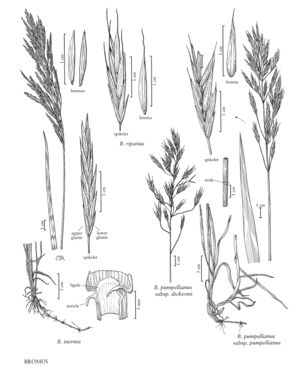Difference between revisions of "Bromus pumpellianus subsp. pumpellianus"
FNA>Volume Importer |
imported>Volume Importer |
||
| (3 intermediate revisions by 2 users not shown) | |||
| Line 36: | Line 36: | ||
|publication year= | |publication year= | ||
|special status= | |special status= | ||
| − | |source xml=https:// | + | |source xml=https://bitbucket.org/aafc-mbb/fna-data-curation/src/200273ad09963decb8fc72550212de541d86569d/coarse_grained_fna_xml/V24/V24_289.xml |
|subfamily=Poaceae subfam. Pooideae | |subfamily=Poaceae subfam. Pooideae | ||
|tribe=Poaceae tribe Bromeae | |tribe=Poaceae tribe Bromeae | ||
Latest revision as of 16:22, 11 May 2021
Plants rhizomatous. Culms 50-120 cm, erect; nodes 2-3(4), usually pubescent, sometimes glabrous; internodes glabrous or pubescent. Sheaths pilose, villous, or glabrous; auricles present on the lower leaves or absent; ligules to 3 mm; blades 9-17(25) cm long, (3)4-8(9) mm wide, abaxial surfaces glabrous or pilose, adaxial surfaces usually pilose, rarely glabrous. Panicles 10-20 cm, open or contracted, erect or nodding; branches erect to spreading. Spikelets 20-30 mm. Glumes glabrous, pubescent, or hirsute; lower glumes (4)5-9 mm, 1-veined; upper glumes (5)8-11 mm, 3-veined; lemmas 9-14 mm, pubescent on the lower portion of the back and along the margins; awns usually present, to 6 mm, sometimes absent; anthers 3.5-7 mm. 2n = 56.
Discussion
Bromus pumpellianus subsp. pumpellianus grows on sandy and gravelly stream banks and lake shores, sand dunes, meadows, dry grassy slopes, and road verges.
Selected References
None.
